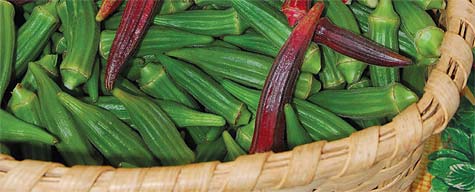
photo by Carole Topalian
By Ellen Robinson and Eric Vanderbeck, REAL School Gardens
What’s that? Okra.
What’s okra? Haven’t you ever tried okra…Fried okra or okra gumbo?
Oh yeah! My grandma cooks Oprah. She makes Oprah gumbo.
—Conversation with a 1st grader in her garden at Sallye Moore Elementary in Grand Prairie.
Where we live, it’s not easy growing food during the hottest weeks of summer… unless you’re growing okra. Okra is a tropical plant, meaning it loves to live where it’s hot and sunny. That makes it a great vegetable to grow here in North Texas, because if there is one thing we have plenty of during our summer months, it’s heat and sunshine. Many people only recognize this tasty Southern vegetable when it’s breaded and deep fried, but there are other healthier options that are absolutely delicious.
Purchase okra seeds at your local garden store and decide where you’re going to grow them. Although okra will probably be happiest planted directly into the ground, with a large enough container (no smaller than five gallons), it can be grown in a pot outdoors. If growing in a container, look for seeds that say the plant is a “dwarf ” variety, which means the plants won’t get very tall.
HERE’S HOW
Choose an area that gets sun most of the day. Plant 2-3 seeds in one hole (just in case they don’t all sprout), about 1/2 inch deep. Measure about 12 – 18 inches away from the first hole and plant another 2-3 seeds. Repeat this for as many okra plants as you want to grow.
Gently water the area you planted with plenty of water. Continue to water every 1-2 days until you see the seedlings (baby plants) begin to emerge in about a week.
After plants are at least 2 inches tall, pull out or cut all but the strongest, healthiest-looking plant in each spot. This helps each plant to grow without having to compete for space, water and nutrients in the soil.
Once plants are up and growing, continue to water every 2-3 days, depending on how quickly water evaporates from the soil. (Not sure? Use your built-in moisture checker. Stick your finger in the soil. If it’s dry past your first knuckle, go ahead and give your plant a drink).
Okra will be ready to harvest (pick and eat) in about 50 – 60 days. First you’ll see beautiful yellow-white flowers, which will need to be pollinated by your hard-working insect friends, and then a small, green finger-looking pod will begin to form where the flower once was. When those green pods are 2 – 4 inches long, they’re ready to be picked, eaten and enjoyed!
Note: If growing okra in a container, follow all of the above, except only grow one plant per pot, and pay extra attention to watering since containers can dry out quickly.
WHO KNEW?
Okra and cotton are cousins! They both come from the “Mallow” plant family. Okra comes in red! Certain varieties of this typically green plant actually produce deep, burgundy red pods. Okra seeds can be roasted, ground and brewed just like coffee.
Hard, woody okra pods have been used to make rope and paper. Although we consider okra to be a vegetable, the pods we eat are actually the fruit of the plant and contain the seeds for making more okra plants.
Okra was brought over to the United States from African countries over 200 years ago. Okra is tastiest when the pods are young—about 2-4 inches long. After that, they become woody and terrible to eat.
RECIPES

REAL School Gardens partners with high-poverty elementary schools to create learning gardens that boost academic achievement, promote healthy lifestyles, cultivate pro-social skills and behaviors, and foster environmental stewardship. The organization currently supports gardens at 74 elementary schools across five urban school districts in North Texas. www.realschoolgardens.org
Edible Dallas & Fort Worth is a quarterly local foods magazine that promotes the abundance of local foods in Dallas, Fort Worth and 34 North Texas counties. We celebrate the family farmers, wine makers, food artisans, chefs and other food-related businesses for their dedication to using the highest quality, fresh, seasonal foods and ingredients.
-
Edible Dallas and Fort Worthhttps://www.edibledfw.com/author/edibledfw/
-
Edible Dallas and Fort Worthhttps://www.edibledfw.com/author/edibledfw/
-
Edible Dallas and Fort Worthhttps://www.edibledfw.com/author/edibledfw/
-
Edible Dallas and Fort Worthhttps://www.edibledfw.com/author/edibledfw/











